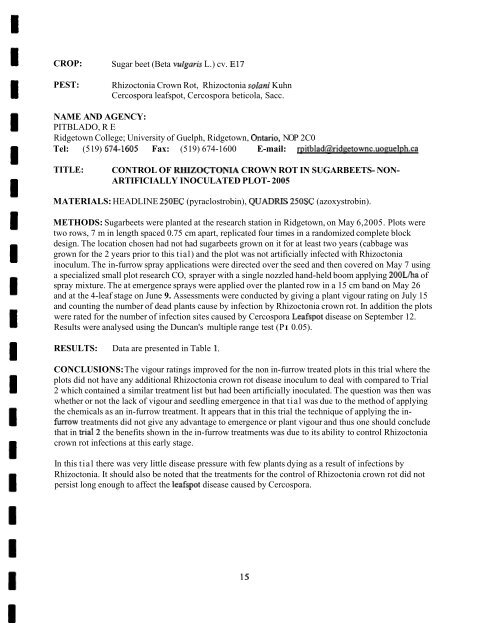ontario sugar beet growers - Atrium - University of Guelph
ontario sugar beet growers - Atrium - University of Guelph
ontario sugar beet growers - Atrium - University of Guelph
You also want an ePaper? Increase the reach of your titles
YUMPU automatically turns print PDFs into web optimized ePapers that Google loves.
CROP:<br />
PEST:<br />
Sugar <strong>beet</strong> (Beta vulgaris L.) cv. El7<br />
Rhizoctonia Crown Rot, Rhizoctonia solani Kuhn<br />
Cercospora leafspot, Cercospora beticola, Sacc.<br />
NAME AND AGENCY:<br />
PITBLADO, R E<br />
Ridgetown College; <strong>University</strong> <strong>of</strong> <strong>Guelph</strong>, Ridgetown, Ontario, NOP 2C0<br />
Tel: (5 19) 674-1 605 Fax: (5 19) 674-1600 E-mail: mitblad@,ridgetownc.uoguelph.ca<br />
TITLE:<br />
CONTROL OF RHIZOCTONIA CROWN ROT IN SUGARBEETS- NON-<br />
ARTIFICIALLY INOCULATED PLOT- 2005<br />
MATERIALS: HEADLINE 250EC (pyraclostrobin), QUADRIS 250SC (azoxystrobin).<br />
METHODS: Sugar<strong>beet</strong>s were planted at the research station in Ridgetown, on May 6,2005. Plots were<br />
two rows, 7 m in length spaced 0.75 cm apart, replicated four times in a randomized complete block<br />
design. The location chosen had not had <strong>sugar</strong><strong>beet</strong>s grown on it for at least two years (cabbage was<br />
grown for the 2 years prior to this tial) and the plot was not artificially infected with Rhizoctonia<br />
inoculum. The in-furrow spray applications were directed over the seed and then covered on May 7 using<br />
a specialized small plot research CO, sprayer with a single nozzled hand-held boom applying 200Lha <strong>of</strong><br />
spray mixture. The at emergence sprays were applied over the planted row in a 15 cm band on May 26<br />
and at the 4-leaf stage on June 9. Assessments were conducted by giving a plant vigour rating on July 15<br />
and counting the number <strong>of</strong> dead plants cause by infection by Rhizoctonia crown rot. In addition the plots<br />
were rated for the number <strong>of</strong> infection sites caused by Cercospora Leafspot disease on September 12.<br />
Results were analysed using the Duncan's multiple range test (PI 0.05).<br />
RESULTS: Data are presented in Table 1.<br />
CONCLUSIONS: The vigour ratings improved for the non in-furrow treated plots in this trial where the<br />
plots did not have any additional Rhizoctonia crown rot disease inoculum to deal with compared to Trial<br />
2 which contained a similar treatment list but had been artificially inoculated. The question was then was<br />
whether or not the lack <strong>of</strong> vigour and seedling emergence in that tial was due to the method <strong>of</strong> applying<br />
the chemicals as an in-furrow treatment. It appears that in this trial the technique <strong>of</strong> applying the infurrow<br />
treatments did not give any advantage to emergence or plant vigour and thus one should conclude<br />
that in tial2 the benefits shown in the in-furrow treatments was due to its ability to control Rhizoctonia<br />
crown rot infections at this early stage.<br />
In this tial there was very little disease pressure with few plants dying as a result <strong>of</strong> infections by<br />
Rhizoctonia. It should also be noted that the treatments for the control <strong>of</strong> Rhizoctonia crown rot did not<br />
persist long enough to affect the leafspot disease caused by Cercospora.

















